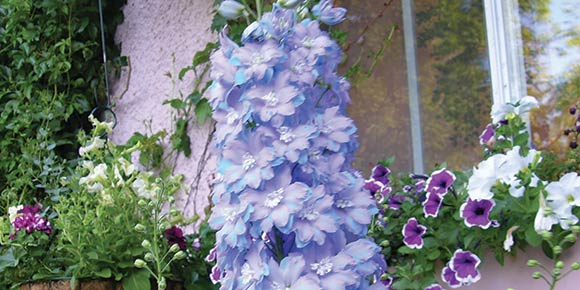Delphinium is one of the loveliest of all flowers in the garden, and it was named by the Greeks for the loveliest creature of the sea. The word delphinium comes from the Greek delphis, for dolphin. Delphs signify an open heart and ardent attachment. Delphinium is July’s birth flower.
Closely related is larkspur, an annual and shorter variety of delphinium. It was called larkspur by the British because they believed its flower resembled the claw of a lark. Larkspurs project lightness and swiftness.
Delphinium is the only flower to have had its own dedicated art show. Edward Steichen (1879 to 1973) was, by day, a fashion photographer for such Condé Nast publications as Vogue and Vanity Fair, but on his own time, he was a grower of delphiniums. He mounted a show in the Museum of Modern Art in the summer of 1936, showing his seven-foot tall delphiniums. To get them that tall, he fed them a cocktail of colchinine (a derivative from the
autumn crocus. Crocus is also used to treat gout). Colchinine is a chemical mutagen that promotes chromosome doubling. Steichen’s delphs were
giants of their times. His delphinium, ‘Connecticut Yankee’, named in honour of Mark Twain, is still available today.
Although it has a reputation for good, few are aware that Delphinium elatum, the common garden variety delphinium, is a powerfully poisonous plant, containing an alkaloid called delphinine. This
alkaloid has properties very like those drawn from Aconitum (monkshood), although a bit weaker. Nevertheless, delphinine kills in much the same way, attacking the heart.
Prescribed in minute quantities by those who know their art, delphinium has been used to treat dropsy (a weakening of the heart that causes water to build in the body), to treat gout and as a parasiticide. Indeed, it was used effectively during World War I to treat lice and their nits in the hair. Juice from
delphinium leaves is said to relieve bleeding hemorrhoids and relieve spasmodic asthma. Juice from the flowers was used to relieve colic in babies.
Delphiniums were useful in other ways, too. The flowers were ground into powder then mixed with alum to make a very good blue ink. The flowers were also used to make blue dye to colour yarns and other fabrics.
If you’re growing delphiniums, they are happiest in deep, rich soil with even moisture and lots of compost. They are heavy feeders enjoying a diet of compost, fortified by a periodic binge on fertilizer. In spite of all this nourishment, alas, they are short lived, losing some of their vitality after the second or third year. If they don’t self-sow in your garden, re-plant a few each year. You can also take basal cuttings to propagate your favourites.
The delphinium leaf tier, Polychrysia esmeralda, is a golden winged moth that infests delphiniums (and monkshood, larkspur and globeflower) by overwintering near the bottom of their hollow stems then emerging to create silken nets on leaves and blossoms. The larvae they lay contentedly eat their way into the heart of the flower buds, destroying the buds as they do so. Dispose of the worms by hand and cut your delphs to the ground in fall to annihilate the worms’ winter home.
The most common disease is sclerotinia rot, a fungus that, given the chance to mature, will turn the plant black before it produces its stone-like spores that can drop and remain in the soil for many years. Aster yellows also attack delphiniums. It can turn the leaves yellow and wilts the plant.
There are many choices of delphinium, but a few might include the earliest hybrids, ‘Blackmore and Langdon’, introduced in England in 1905. The flowers are pastel blue, white, lavender, violet and
indigo. ‘Pacific Coast Giants’ are seven feet tall and come in blue and pink. ‘Magic Fountains’ are only about 30 inches tall. ‘Blue Mirror’ is gentian blue. ‘Green Twist’ is creamy white with green overtones.
If you love delphiniums, there are delphinium clubs to join and learn from. Try www.ondelphiniums.com.
Dorothy Dobbie is the publisher of Manitoba Gardener and she produces a weekly radio show on CJNU 93.7 FM AT 8:00 on Sunday mornings. If you would like to subscribe, call 204 940 2700 or go to localgardenr.net.



